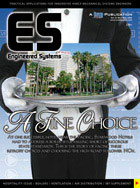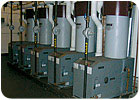

Independent boiler plants met the facility's heating and DHW needs. The two boilers designated for the DHW loop each had a 1.7-MMBtu capacity and fed a 750-gal hot water storage tank. The building heat loop was fed by a 4-MMBtu boiler with a second 4-MMBtu boiler to provide redundancy.
Given the temperate climate, the property had little need for the full 4 MMBtu of heat the boilers were designed to provide. Although occupant demand calls for heating to be available almost year-round, the actual energy consumption is quite low. Indeed, the demand on the existing building heat loop was so low, the boilers were not subject to the SCAQMD's demanding emissions standards as neither boiler used more than 9,000 Therm/yr. Additionally, the low demand allowed the building engineers to isolate the unused boiler and therefore avoid a situation where the second boiler radiated unnecessary heat back into the building.

FIGURE 1. Cost benefit analysis used to determine the course of action for the Long Beach Westin.
Recent changes to the operation of the property included the installation of ozone systems for the laundry functions, which significantly reduced the DHW load in the facility and brought it well below the specifications of the original design. As a result, the boilers dedicated to meeting the DHW demands were also operating at well below their capacity.
Both boiler loops were operating at approximately 1% of their annual capacity. Given the similar operational efficiency of the two systems and allowing for calculation errors at a factor of five, the seasonal efficiency of the boiler plant still would not surpass 30%. Nevertheless, operating costs for the boiler plants were not prohibitive and demand was met adequately, a threshold of operational functionality that is satisfactory by most standards.

FIGURE 2. The original 4-MMBtu boiler at the Long Beach Westin. The owner, Starwood Hotels, decided to redesign its boiler plant to lower NOx emissions and to increase efficiency.
DESIGNING FOR THE FUTURE
The single motivation for a re-evaluation of the boiler plants at the Westin Long Beach was the citation from SCAQMD. Starwood invited an outside energy management consulting firm, Energy Management Strategies, Inc. (EMSI), to evaluate the property and propose solutions to bring the DHW boilers into compliance with California state standards.Only three options made sense. First, they could simply retrofit the existing boilers to reduce NOx emissions, because the efficiency of the boiler loop would have dropped as well. The advantage of retrofitting the boilers is the low cost of the solution and the retrofitting process has the least impact on the operations of the facility.
The second option was to exchange the original boilers with new boilers on a one-for-one basis. This would reduce the NOx emissions, and would be relatively inexpensive as a one-for-one exchange requires little reengineering and no analysis.
The final option was to redesign the boiler plant in its entirety. This would address the NOx issue as well as producing a right sized boiler plant that met the real-time needs of the facility. The overall efficiency of the boiler plant would increase dramatically, from only 1% to over 95%. However, a complete redesign of the boiler plant meant the most disruption to the facility itself, as well as the largest investment of any of the three options.

FIGURE 3. The new heat exchanger and pump configuration installed at the Long Beach Westin.
After performing an investment-grade audit of the existing system, a full study of the alternatives, and a complete financial analysis, EMSI returned with both the plan for renovation and the financial analysis to justify a complete reconfiguration of the existing boiler plant. Extensive building simulations indicated that the facility's demand peaked at 4 MMBtu.
The design for the new boiler plant was based on the detailed analysis and due diligence performed by EMSI. Right-sized at 5 MMBtu, the new boiler plant is designed with 1-MMBtu modular boilers, which allow the plant to ramp up according to building demand, but also to scale back when demand is low. The modular design builds redundancy into the system with the fifth 1-MMBtu boiler.
EMSI recommended the installation of KC1000 boilers by AERCO due to their low NOx emissions and the fact that they met the air quality standards required by SCAQMD. Starwood accepted the proposal, drew up scope of work documents, and put the project to bid. A Fullerton, CA, firm - Automatic Boiler Company - was selected to perform the removal and replacement of the boiler plant, including the proprietary boiler management system.
The plant was designed with future upgrades in mind: When the DHW loop that feeds guest rooms needs to be replaced, additional modules can be added to the new configuration.

FIGURE 4. The peak load demand at the Long Beach Westin was 4 MMBtu. Consequently, four 1-MMBtu modular boilers, which allow the plant to ramp up according to building demand, were installed. A fifth 1-MMBtu boiler provides redundancy.
CONCLUSION
Starwood Hotels continues to demonstrate why they are a leader in both the hospitality industry and the Southern California business community. Rather than doing the bare minimum to fulfill the State regulations for NOx emissions, Starwood chose to comply with the spirit of the law, even as it became clear the property would not remain part of their portfolio.At What Cost A ‘Comp'?
Energy management's obvious impact area is in energy expenditures and smooth operation, but what is energy management's potential impact on guest satisfaction?At one time, guest complaints about heating, air conditioning, or the availability of unlimited hot water were a nuisance but had little impact on the bottom line. Those days are gone. There are more hospitality choices available to the consumer, while the Internet can turn one dissatisfied guest into a public relations nightmare. In an attempt to retain their competitive edge, many hotels commonly give dissatisfied guests a partial or full refund of the price of a room to compensate for the lapse in service.
Outdated, improperly sized, poorly maintained, or non-functional boiler plants lower the profit margins in the hospitality industry. Take, for instance, a hypothetical 300-room hotel with an underperforming DHW plant. Assuming that the DHW system is operating at 90% of capacity, the facility can expect a minimum of 30 guests to check out with major complaints about their cold showers. If each of those rooms is sold at $150 and is written off in its entirety, the property loses $4,500 before the additional costs of operation are factored in. Five nights like that in a quarter and a property is looking at an annual loss of $90,000.
This is a hypothetical scenario - given the proprietary nature of balance sheets, a real-world example is unavailable - but a facility can run its own analysis to calculate the annual cost of an underperforming system. By any calculation, a poorly functioning boiler plant is a liability: its inefficiency raises the cost of operation and jeopardizes guest satisfaction.
In many cases, decisionmakers approach their mechanical systems as an isolated component of the facility. Mechanical issues are resolved with no consideration for the impact on energy expenditures; energy management issues are considered with no regard to their positive impact on the rest of the facility. In reality, guests do not make a distinction between satisfaction with their hotel stay and the availability of a hot shower in the morning.
